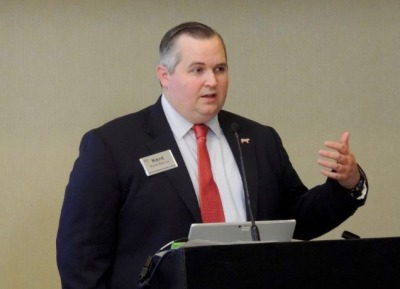Now that the Trump administration has officially informed Congress that it intends to begin negotiations with Japan on a free trade agreement, anticipation is growing for a new deal that’s expected to significantly boost U.S. exports of beef, dairy, pork, rice and other commodities.
Japanese Prime Minister Shinzo Abe confirmed last month that, after months of rebuffing U.S. requests for an FTA, Japan was willing to negotiate a deal outside of the Trans-Pacific Partnership (TPP), which the U.S. pulled out of nearly two years ago.
And on Tuesday the Trump administration made it official, notifying Congress not just on its plan for a trade deal with Japan, but also with the European Union and the U.K.
“Japan is an important, but still too often underperforming market for U.S. exporters of goods,” U.S. Trade Representative Robert Lighthizer said in the letter to Congress on Japan.
The U.S. exported $12 billion worth of ag commodities like wheat, corn, dairy, beef, pork and sorghum to Japan last year, making it the fourth-largest foreign market for U.S. farm goods.
“Despite these significant trade volumes, U.S. exporters in key sectors such as automobiles, agriculture and services have been challenged by multiple tariff and non-tariff barriers for decades,” Lighthizer said.
Support was widespread in the U.S. agriculture sector for the TPP, but most of the anticipation for increased trade from what was then a 12-country trade pact was expected to come from Japan.

U.S. Trade Representative Robert Lighthizer
Lighthizer, according to several senators he met with last week, was upbeat about the prospects of negotiations with Japan and that enthused lawmakers like Senate Agriculture Committee Chairman Pat Roberts, R-Kan.
“We’d like to do more in beef,” Roberts said about prospects for increased trade with Japan. “Australia sort of took that market away from us.”
The U.S. sells over $1 billion of beef per year to Japan, but steep tariffs on fresh and frozen cuts of American meat are giving a trade edge to Australia because it already has an FTA with the Asian importer. The TPP would have cut tariffs on U.S. beef to just 9 percent over 16 years, from the current 38.5 percent, according to an analysis by the U.S. International Trade Commission. Roberts and other lawmakers hope the Trump administration can negotiate a deal at least as good as that one or perhaps even better.
U.S. beef exports to Japan would have seen one of the biggest trade bumps under the TPP, according to the ITC report. Japan, already the largest foreign market for U.S. beef, would be buying an additional $840 million worth of the meat after 15 years if the U.S. had stayed in TPP.
“We’re very excited about this development,” said Kent Bacus, director of international trade for the National Cattlemen's Beef Association. “We need to have a competitive advantage there so we need a trade agreement to be implemented as soon as possible.”
U.S. pork producers, who are always pushing to expand international access, could also benefit immensely from an FTA with Japan.

Kent Bacus, NCBA
“NPPC is ecstatic that the Trump administration will be engaging in trade negotiations with Japan,” a spokesman for the National Pork Producers Council told Agri-Pulse. “Unfettered market access to Japan will allow the U.S. to maintain and expand its share of the Japanese pork market, thereby creating American jobs. In 2017, the U.S. shipped more than $1.6 billion of pork to Japan, and those exports supported more than 13,000 U.S. jobs.”
Japan agreed under TPP to eliminate a 20 percent tariff on ground pork and a 10 percent tariff on sausage within six years. Also, Japan would have immediately cut in half a 4.3 percent tariff on all fresh, chilled and frozen pork and reduced government intervention in the market by scaling back its “gate price” system that’s often used to set prices on imports in an effort to favor domestic product.
“Under the TPP, tariffs on U.S. pork going to Japan would have been phased out over 11 years,” the NPPC spokesman said. “As we have done in every other U.S. FTA, NPPC would make its support for a U.S.-Japan FTA contingent on Japan eliminating all tariff and non-tariff barriers to U.S. pork.”
It's not just meat that Japan buys. California farmers sell a lot of rice to the island nation, and they stand to sell a lot more under an FTA.
Japan buys almost exclusively medium and short grain rice, which is primarily grown in California. Under the TPP, Japan agreed to several measures including a 50,000-ton duty-free quota for U.S. rice that would rise to 70,000 tons in 13 years.
If Japan were to agree to a similar deal, it would be a clear win for the U.S. The USA Rice Federation only tepidly supported the TPP because of provisions in the deal that would have negatively impacted long grain rice farmers from states including Arkansas and Louisiana. Mexico, a TPP member, is their largest foreign buyer, and a TPP provision could have cut into those sales. Mexico agreed to gradually lift its 20 percent tariff on Vietnamese rice under the deal, a concession that would have likely cut into U.S. market share.
Beyond the U.S., Japan, Mexico and Vietnam, the other members of the original TPP were Canada, Australia, Brunei, Chile, New Zealand, Peru, Singapore and Malaysia. All but the U.S. have decided to continue on.
For more news, go to: www.Agri-Pulse.com


